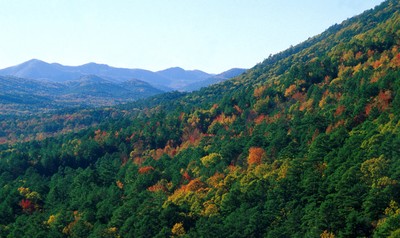How Do Exotic Plants Invade Mountains?
In contrast to native
plants that have currently peaked in richness (number of species) at
mid-elevations, nonnative plants are still mostly concentrated at lower
elevations. However, due to human activities, land use, and increasing
temperatures, exotic plants may spread upwards into higher elevations
(mountaintops), posing significant extinction risks for native species.
 Mountains often serve as biodiversity hotspots. Much is known about the
elevational patterns of native species diversity and the mechanisms that drive
these patterns. A similar level of understanding is needed for exotic, or nonnative,
species. A study published in the Journal
of Biogeography and led by an Eastern Forest Environmental Threat
Assessment Center scientist indicates that, at present levels of
invasion, nonnative and native species show different patterns in both
distribution and diversity along elevational gradients worldwide. The highest
richness of exotic plants is at low elevations mostly because human populations
and activities have been concentrated at low elevations. However, researchers’ observations
constitute a snapshot of ongoing, long-term invasion processes. At present, human
activities are increasingly shifting upwards and some preferentially onto
mountaintops due to tourism, mining, and skiing, among other activities. As
nonnative species typically show strong associations with human activities,
future changes in human population (e.g., growth and migration), land use, and
climate may promote upward spread of nonnative species and thus increase
risks of impacts on native species and communities.
Mountains often serve as biodiversity hotspots. Much is known about the
elevational patterns of native species diversity and the mechanisms that drive
these patterns. A similar level of understanding is needed for exotic, or nonnative,
species. A study published in the Journal
of Biogeography and led by an Eastern Forest Environmental Threat
Assessment Center scientist indicates that, at present levels of
invasion, nonnative and native species show different patterns in both
distribution and diversity along elevational gradients worldwide. The highest
richness of exotic plants is at low elevations mostly because human populations
and activities have been concentrated at low elevations. However, researchers’ observations
constitute a snapshot of ongoing, long-term invasion processes. At present, human
activities are increasingly shifting upwards and some preferentially onto
mountaintops due to tourism, mining, and skiing, among other activities. As
nonnative species typically show strong associations with human activities,
future changes in human population (e.g., growth and migration), land use, and
climate may promote upward spread of nonnative species and thus increase
risks of impacts on native species and communities.Pictured: Mountains often serve as biodiversity hotspots, but future changes in human population, land use, and climate may promote upward spread of nonnative species and extinction risks for native species. Photo by USDA Forest Service.
Related publications:
External Partners/Collaborators: University of Florida, Purdue University, Peking University, Monash University
Contact: Qinfeng Guo, Research Ecologist, qinfeng.guo@usda.gov



